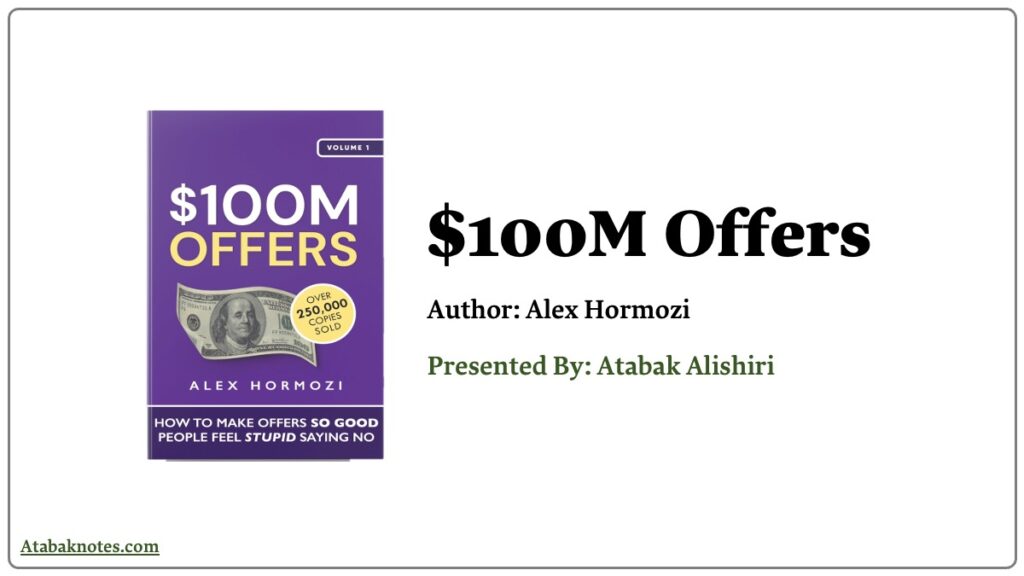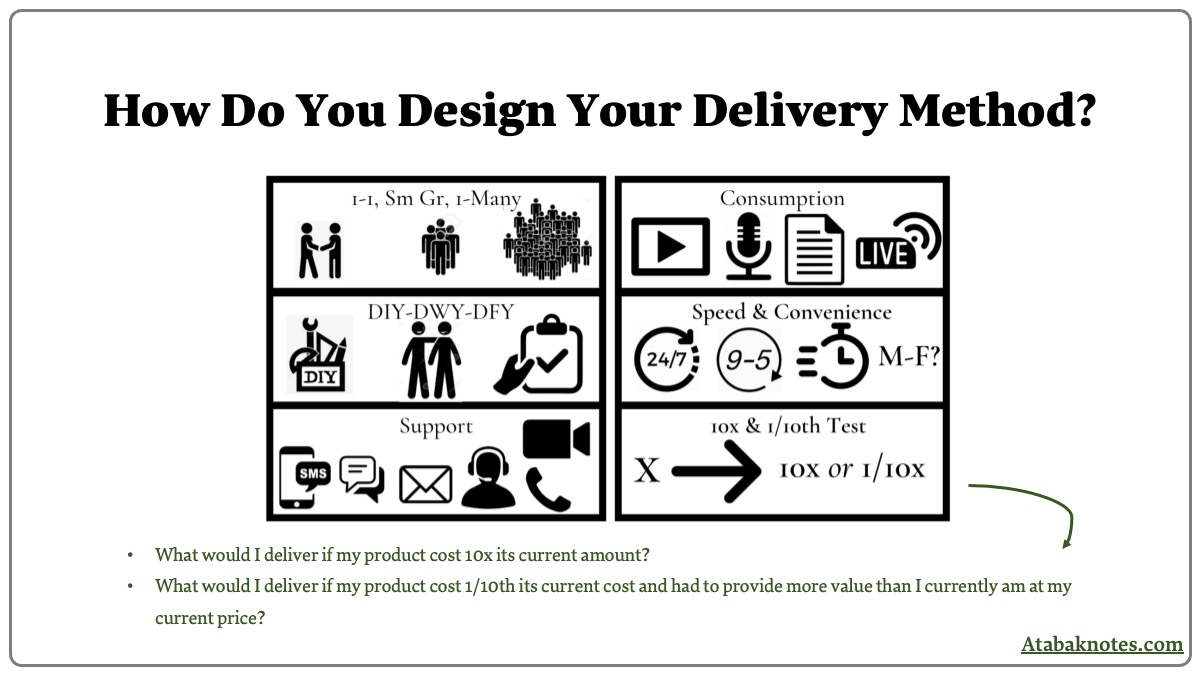If there’s one thing I’ve learned in my journey as a professional, it’s that creating value isn’t just about having the best product or service. It’s about how you present that product or service to the world. Recently, I dove into Alex Hormozi’s $100M Offers, and it struck me just how critical it is to craft offers that are so compelling, so valuable, that saying no feels like a mistake.
Whether you’re a seasoned entrepreneur, a budding startup founder, or simply someone looking to make their mark, the principles in $100M Offers are gold. Let’s explore how these principles can be applied, drawing from my own experiences and the insights Hormozi shares.
Why Crafting a Compelling Offer?
In today’s market, where consumers are bombarded with endless choices, standing out is tougher than ever. It’s not enough to have a good product; you need an exceptional offer that grabs attention and makes your audience feel that your product is the solution they’ve been searching for. This is where Hormozi’s framework shines—it’s not just about what you offer, but how you package it.
The essence of Hormozi’s approach is simple yet powerful: create an offer that is so good, that it would be “stupid” to say no. But how do you achieve this? It starts with understanding your audience, their needs, and how your product can solve their most pressing problems. Let’s break down the process step by step.
Identifying and Understanding Your Target Audience
The first step in crafting an irresistible offer is understanding exactly who you’re targeting. It might seem counterintuitive, but the more narrowly you define your audience, the more effective your offer will be. Why? Because when you try to appeal to everyone, you end up resonating with no one.
Take, for example, a course we’re developing in Business English. If I market this course as “for anyone who wants to learn English,” it’s too broad. The messaging becomes diluted, and potential customers might not see how the course directly applies to their specific needs. Instead, by targeting “Farsi-speaking professionals who need to close deals in English,” the offer becomes sharply focused. It’s immediately clear who the course is for and how it will benefit them.
Digging Deep into Core Pain Points
Once you’ve identified your target audience, the next step is to dig deep into their pain points. What problems are they facing that your product or service can solve? The more specific and urgent these problems are, the more powerful your offer will be.
Let’s go back to the Business English course. For a Farsi-speaking professional, the pain points might include:
– Limited Career Opportunities: They might feel stuck in their career because they can’t communicate effectively in English, which is the global business language.
– Lack of Confidence in Meetings: Even if they understand English, they might struggle to express themselves confidently in high-stakes meetings or negotiations.
– Difficulty Networking: Building relationships with English-speaking colleagues or clients might feel intimidating and challenging.
By addressing these pain points directly, you’re not just offering a course—you’re providing a solution that could significantly improve their professional life.
Listing Problems as Solutions: A Unique Approach
One of the most innovative techniques in Hormozi’s framework is the idea of listing problems as solutions. This might sound counterintuitive at first, but it’s incredibly effective. The idea is to acknowledge the challenges your audience faces and then present your offer as the solution to those challenges.
For example, you could list the following:
– Problem: “I don’t have time to study English after work.”
– Solution: “Learn Business English on your schedule with our flexible, self-paced modules.”
– Problem: “I’m afraid of making mistakes in English.”
– Solution: “Build confidence with our supportive, mistake-friendly learning environment.”
This approach not only shows that you understand your audience’s struggles but also positions your offer as the perfect solution to their problems.
Optimizing the Value Equation
One of the most insightful parts of Hormozi’s framework is the idea of optimizing the value equation. This involves adding so much value to your offer that it becomes irresistible. But it’s not just about throwing in bonuses or additional features; it’s about strategically enhancing the perceived value of your offer.
Here’s a practical way to think about it: Imagine you’re selling a car. The car itself is great, but what if you added free maintenance for a year, a premium sound system, and exclusive access to a driving club? Suddenly, the perceived value of the car increases dramatically.
For the Business English course, consider what additional value you could offer:
– Personalized Coaching: Offering one-on-one sessions where students can practice their English skills in a business context.
– Exclusive Resources: Providing access to a library of business English materials, such as templates for emails, presentations, and contracts.
– Lifetime Access: Ensuring students have access to course updates and new materials for life.
These extras not only enhance the value of the course but also address specific needs that your target audience might have.
Designing an Effective Delivery Method
How you deliver your offer is just as important as the offer itself. Hormozi suggests thinking about what you would deliver if your product costs 10 times its current amount. This forces you to consider ways to over-deliver on value.
For instance, imagine your Business English course costs $500. Now, think about what you would include if it cost $5,000. Perhaps you would add:
– Daily Practice Sessions: Instead of just weekly lessons, offer daily practice opportunities with native speakers.
– Personalized Feedback: Provide detailed feedback on every assignment, ensuring that each student understands their mistakes and how to improve.
– Lifetime Coaching: Include lifetime access to coaching sessions, allowing students to continue improving their skills long after the course ends.
By thinking in this way, you can identify opportunities to enhance your offer and make it even more valuable to your customers.
Crafting an Offer So Good That Saying No Feels Impossible
Now that you’ve optimized the value, it’s time to package your offer in a way that makes it feel irresistible. Hormozi emphasizes the importance of scarcity and urgency—two psychological triggers that can significantly boost conversions.
The Power of Scarcity and Urgency
Scarcity creates a sense of exclusivity. When something is limited, it becomes more desirable. For example, you could limit the number of spots in your Business English course. Instead of offering the course to an unlimited number of students, you could say, “Only 50 spots available.” This creates a sense of urgency and prompts potential customers to act quickly.
Another approach is to offer a limited edition of the course. For instance, you could include bonus content or additional coaching sessions only for the first cohort of students. This not only adds value but also makes the offer more appealing.
While scarcity limits the quantity, urgency limits the time. By creating a deadline for your offer, you push potential customers to make a decision sooner rather than later. This can be particularly effective if combined with a special discount or bonus that’s only available for a short time.
For example, you could offer a “Fast-Action Bonus” for those who enroll within the first 24 hours. This could be an additional coaching session or a discount on the course price. By creating a sense of urgency, you encourage quick decision-making and reduce the chances of customers procrastinating.
Adding Bonuses That Truly Matter
Bonuses are a great way to add perceived value to your offer, but they need to be relevant and meaningful. Hormozi emphasizes that your bonuses should solve the next problem your customer will face.
For example, after someone completes your Business English course, their next challenge might be applying their skills in real-world situations. A valuable bonus could be:
– Networking in English: A bonus course on how to network effectively in English-speaking environments.
– Job Interview Preparation: Tips and strategies for acing English-language job interviews.
These bonuses not only add value to the core offer but also address future needs, making your offer even more compelling.
The Power of a Strong Guarantee
Offering a strong guarantee can alleviate any lingering doubts your potential customers might have. Hormozi discusses different types of guarantees, from unconditional (no questions asked) to conditional (based on specific outcomes).
For our Business English course, we could offer a “Fluency Guarantee”—if students don’t reach a certain level of fluency after completing the course, they get additional coaching for free until they do. This type of guarantee not only builds trust but also shows that we’re confident in the value of your offer.
Another approach could be an “Achievement Guarantee”—if students don’t pass a certain benchmark (e.g., a business English proficiency test), they receive a full refund. This kind of guarantee reduces the perceived risk for the customer and can be a powerful motivator.
Naming Your Offer: The M-A-G-I-C Formula
One of the final touches on a compelling offer is its name. Hormozi introduces the M-A-G-I-C formula, which stands for:
– Magnetic Reason Why: Clearly explain why your offer is valuable.
– Announce Your Avatar: Specify who the offer is for.
– Give Them a Goal: Define a specific, desirable outcome.
– Indicate a Time Interval: Set a clear timeframe for achieving the goal.
– Complete with Container Word: Use a strong word that encapsulates the entire offer.
For example, the Business English course could be named:
“Close Deals in English Like a Pro in 60 Days with Lingano: The Complete Business English Masterclass for Farsi-Speaking Professionals.”
Each element of the M-A-G-I-C formula is present:
– Magnetic Reason Why: “Close Deals in English Like a Pro”
– Announce Your Avatar: “Farsi-Speaking Professionals”
– Give Them a Goal: “Master Business English Communication”
– Indicate a Time Interval: “60 Days”
– Complete with Container Word: “Masterclass”
This name not only makes the offer clear and compelling but also communicates the value and the outcome that students can expect.
Wrapping Up: Turning Principles into Practice
Creating an irresistible offer isn’t about being flashy or using high-pressure tactics. It’s about understanding your audience, addressing their needs, and delivering value that exceeds their expectations. Alex Hormozi’s framework provides a clear roadmap for doing just that.
As I’ve applied these principles to our own projects, I’ve seen firsthand how effective they can be. Whether you’re developing a new product, launching a course, or simply trying to improve an existing offer, these strategies can help you create something truly exceptional.
If you’re looking to take your offers to the next level, I highly recommend reading $100M Offers and putting these techniques into practice. Thanks for reading, and as always, feel free to reach out with any questions or thoughts.












